VO2max Development
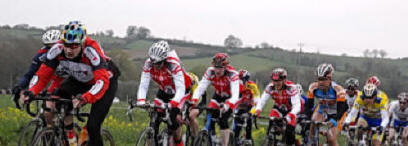
VO2max Developed
Lining it out ~ Sable sur Sarthe ~ Le Mans
Every rider has their own "favourite" measuring metric for determining fitness levels; usually it's the easiest or least painful thing to measure. For coaches and sports scientists the three main metrics you'll find in their armoury and coaching manuals are:
▼ Lactate Threshold
▼ Functional Threshold Power and
▼ VO2max
We cover Lactate Threshold (which isn't) and Functional Threshold (which is) in other factsheets; for today it's the sole turn of VO2max. But first some background.
The
Obvious Paradox
Cycling is completely different to most sports as it has many
elements of athletic capacity that must be developed to realize full
sporting potential. Generally, runners mainly run at one set pace; marathon, 1500 metres, 400 metres, 100 meters etc,
etc. Each runner in each respective discipline will run at, broadly speaking, a
set pace throughout the duration of the event. Swimming is pretty much the same;
as is time trialing but we'll slyly ignore that for now!
Cycling is quite dynamic in the sense that during a road race or a sportive the pace and terrain is constantly changing. The first miles of settling in, the early attacks, the middle tempo consolidation, the shifting pace of a racing climb, the build up to a high speed finale and then the crescendo of the all out lung-busting sprint.
Endurance runners have a pretty much well defined pace to train and target. If you want to run at six minute miles you train to compete at six minute miles. So, taking in to account the description above, where do you start for cycle racing?
In an average cycling road race or sportive the competitor has to flip-flop between a marathon pace, a sprinting pace and everything else in between. That's what makes our sport so great, demanding and enjoyable! You just don't know what's going to happen next.
What to
target?
Each Easter
there is a stage race here in Jersey. It comprises a 3k hilly prologue, a
hilly road
race, a time trial, a
criterium and a
flat road race. The dynamics of
each event are quite, quite different; the constant paced effort of a time
trial hardly bears comparison with the cut and thrust accelerations of a
closed-circuit criterium!

So where do you begin when you want to develop the aspects of your physiology that will bring the best return on your training time investment? Well as luck would have it, for this article at least, it's VO2max development.
What is it?
VO2max is, as discussed in the
VO2max factsheet, pretty much genetically
determined. Your heart and your lungs and your genes will determine
what will be your VO2max ceiling.
But are you maximising your potential utilization of VO2max? Can you operate closer to your ceiling without blowing up?
As it says, in the above factsheet, VO2max can loosely be described as:
"the maximum amount of oxygen you can take in and make use of "
So, the very nature of trying to develop our VO2max requires us to push back the boundaries of suffering, to allow our bodies to adapt and draw more oxygen from the air we breath and fire it into our muscles.
To target and develop your VO2max you need to undertake interval training; interval training at the right level. Intervals need to be aerobic in nature but right at the edge of aerobicity (my new word, watch out for it in the future) without straying in to anaerobic work.
Dispelling a Myth
It used to be thought that VO2max was developed
through undertaking long, slow, rides to
get the miles in. It was thought that this would drive up oxygen
consumption as you must have consumed loads of oxygen on a long ride by
riding lots of miles and taking lots of breaths.
However, in trained individuals like ourselves, the rate of oxygen consumption at this pace is much too low to force a physiological adaptation. Something else is needed other than mass oxygen consumption. It's okay for the masses, but not finely tuned athletes like ourselves!
Before we discuss what can be done, we again need to understand a little background. It's important you don't just blindly follow an opinion or instruction without first understanding it's context. This next section will hopefully do that...
Blood
Oxygen Relationship
Your average (for the sake of argument a 72 kilo, male) cyclist has
around 30 kilograms of muscle mass hanging off their skeleton.
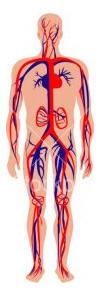 Muscles require blood and
oxygen to work. The heart and lungs push this energy carrying concoction
around the body. The faster you cycle the more demands your muscles
make for oxygen and blood.
Muscles require blood and
oxygen to work. The heart and lungs push this energy carrying concoction
around the body. The faster you cycle the more demands your muscles
make for oxygen and blood.
As you may have discovered, your heart rate, and by definition the rate of flow and volume of oxygen and blood, increases to match this demand.
The capacity for skeletal muscle to utilise oxygen, far exceeds that of the heart and lungs to deliver it. Your heart and lungs in effect become your performance limiter.
So, if you want to go faster all you have to do is build, develop and maximise your oxygen carrying capacity.
That should become the sole objective of your training; getting more oxygen to your muscles.
Training ObjectivesHopefully we're now all agreed (or at least understand) that our training objective is not to go faster. We need to make our bodies become more efficient and effective, to allow more oxygen to be utilized, or make better use of the oxygen we can provide. This is how we get more speed; the speed is a pleasant and welcome result of our main objective.
I've explained this in previous factsheets, so here's a quick refresher.
If we can make our engine bigger, (VO2max) marvelous; we now have the potential to go faster.
If we can make our fuel tank bigger (endurance & stamina), just as marvelous; we now have the potential to go further.
But if we can make our engine and our fuel tank bigger, bloody fantastic! We now have the potential to go faster for longer.
When you can do that better than anyone else, you become a champion.
Champions also work on their rev limit, increase the rev limit (lactate tolerance) and again you are on to a winner. We cover lactate development elsewhere. High revs are no use on a small engine (think moped), so get your engine size maxed out first.
In the world o our VO2max engine, then our heart rate and lung capacity (our effectiveness), are pretty much fixed. You ain't going to double your lung capacity and unless you take the naughty sweets, your blood oxygenation is pretty fixed.
To develop as athletes we need to increase our efficiency. We need to generate and realise more bang per beat than we do currently. To do that we need to do the right training. And more importantly do the right training right. It's so, so, easy to do the right training wrong!
The
Silver Bullet?
The general consensus on effort required to develop VO2max is
to train at between 90 to 105% of your current VO2max capacity.
It should go without typing that "you can ride longer at 90% of your VO2max than you can at 105%". Let's say you can ride for 10 minutes at 90% of your VO2max and 3 minutes at 105% of it.
So which brings the best return? Do you train at a higher effort for less time or more time at less effort? As ever there isn't a simple answer.
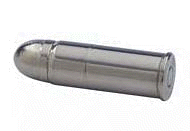 We are all different and we
will all adapt to the same training stimulus in a different way. Some people could be brought to their knees by short intense intervals yet
thrive on long, less-intense efforts.
We are all different and we
will all adapt to the same training stimulus in a different way. Some people could be brought to their knees by short intense intervals yet
thrive on long, less-intense efforts.
Others will be creating little training effect or overload by riding below their optimum.
It's been suggested that the best return on training investment, is multiple efforts at 100% VO2max, for a duration of between 3 and 5 minutes; that'll be 4 minutes then!
Shorter, to a degree, intervals will give a potentially greater overload than longer ones. Although you need to be very careful when trying to elicit a particular physiological response because you might not always get the result you were after.
Riding at a higher intensity, say 120% VO2max, will give a pretty short interval. You could probably hold this intensity for around two minutes. The fact that it takes between 60-180 seconds to physiologically reach your VO2max means the interval could be over before you've actually achieved any VO2max development!
You'll be very hot and bothered, probably very pleased with yourself because you've worked frightfully hard, but you won't have done anything to assist your VO2max development. More isn't always better!
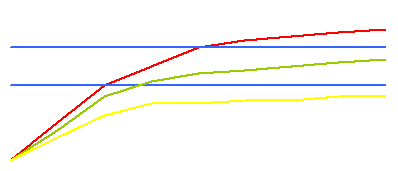
The space between the blue lines in the graphic above represent your VO2max development zone.
Riding too hard, the red line , causes you to go straight through the VO2max development zone, in to anereobicity and totally miss the target.
Once you go out the top of the blue zone you're riding anaerobically (without oxygen) so how are you going to develop your oxygen uptake? You go from miles below, to right past it without stopping at Go and without collecting £200. An opportunity missed.
Riding too soft, the yellow line , doesn't illicit the stimulus you were after and again misses the target. Of course you're riding aerobically (with oxygen) but you're not stressing the system and developing your cause.
If you ride too far below your target, at say 85%, you may never actually reach the development boundary. Not so hot, not so bothered and not achieved anything at all, other than burning some calories.
Riding a four minute interval at 100% of your VO2max; after 90+ seconds, the green line , gets right in the sweet spot. Now you begin to maximise your training time and get a return on all the blood, sweat and tears. Okay, just the sweat.
Measuring VO2max
Gauging the correct effort is
pretty difficult without undertaking some sort of test but it is still
possible without a sexy power meter thingy.
Taking a VO2max Ramp Test will obviously give you the information you need. Taking a wVO2max Test will give an indicator of the wattage being produced at VO2max. From the results of either of these tests, a laser-like power training zone can be determined.
But it is possible to get information, close enough for mortals, through a turbo test or time trial of your own. After a thorough warm up, ride a 20 minute time trial on your turbo and take a note of the average power or speed you can hold for the 20 minutes.
Use this figure to set your 4 minute interval pace. It's not scientifically accurate but it is close enough for our needs.
DO NOT use heart rate. Heart rate lag and cardiac drift will not give you the accuracy you need to perform short duration intervals. By time your heart's caught up you could be way out the top of your zone and ruining a perfectly good workout opportunity.
VO2max
Stealers
Those that have ridden in the mountains will
testify that the air is a) colder, b) nicer smelling and c) less dense.
It's the last one that concerns us.
Living in Jersey I'm about 12 feet or 4 metres above sea level. When I'm in the Alps or Pyrenees, I'm significantly higher. At 5,000 feet, just 1600 metres there is a 5-7% decrease in VO2max.
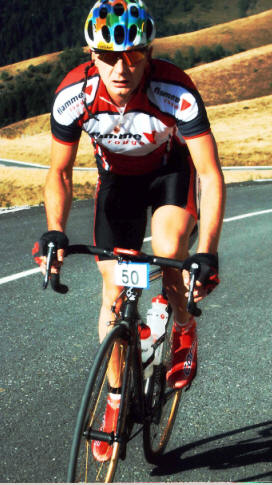
Climbing mountains is hard enough due to gravitational challenges without having to factor in the fact that the air gets less dense the higher you climb, a true double whammy.
So altitude causes you VO2max problems unless you go there to live. The fact that the air is so thin forces your body to adapt, so when you come back down to sea level your all turboed up. Live high - train low!
Once you hit 20 years old your VO2max potential is pretty much where it's going to be.
However, cyclists generally reach their physical peak, when experience, genetics, training and adaptation all gel together, at around 30 years old.
After that it's harder to maintain a stable VO2max figure. In fact there can be a drop of approximately 30% between the ages of 20 and 65, with the rate of decrease gathering pace once past 40 years old.
Hence the setting of the age benchmark for veterans. You can stave off the rate of degradation through training, nutrition and lifestyle choices. But time will get you in the end; it's just fun trying to keep it at arms length for as long as you can.
The Message
The pre-competition period is the perfect time to develop your VO2max.
The weather's getting better, the new season is just around the corner and
you're likely to be past the germ catching phase of the winter. Your
base should be well developed and it's now time to start looking for that
icing on the cake.
If we assume a theoretical "perfect" VO2max interval is 4 minutes at 100% VO2max, and it takes 90 seconds to reach VO2max, then we are "developing" our VO2max system for 2.5 minutes of that 4 minute interval. Not a bad return; string four or five intervals together and it all begins to add up.
When you're feeling good, don't be tempted to ramp up the wattage by pushing harder to get more return. It doesn't work like that! Once you move out of the "training with oxygen zone" you aren't developing your oxygen capacity. You don't develop VO2max by riding as hard as you can for four minutes.
If you can only manage four, 4 minute intervals then you probably went too hard (red line). If you can "just" manage five, 4 minute intervals (green line) you're probably right in the ball park. If you can do six, then you were probably not going hard enough (yellow line).
There's more to cycling than a high VO2max. Nutrition, tactics, ability to suffer, mental strength and equipment all form part of the jigsaw that make up you. But developing your VO2max through five, 4 minute intervals once a week will help you on your way to far better results than a sexy new frame.
It may hurt a bit more and not be as flash as a new bike, or wheels, but it's probably the main contributing factor to top results and performances.
Train hard, train right and train to a purpose. The rewards, be they personal or trophy-based, will come as sure as night follows day.
Suffer well, but not too well...








